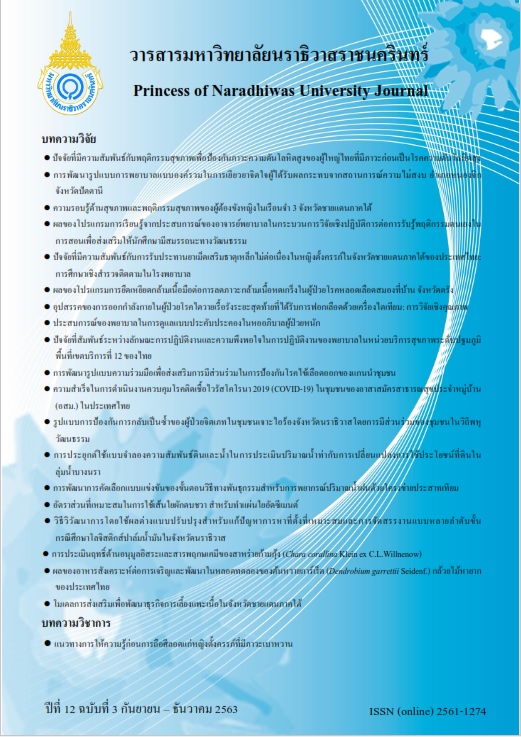Health Literacy and Health Behavior of Female Prisoners in Three Southern Border Provinces
Keywords:
Health Literacy, Health Behavior, Female prisoners, Southern border provincesAbstract
This survey research aimed to study health literacy and health behaviors of female prisoners in three southern border provinces of Thailand. The health literacy and health behaviors questionnaires were used to collect data. The tools used were adjusted according to the assessment of the Health Education Division, Ministry of Public Health. The tools were verified by professionals and their reliability was 0.72 and 0.71, respectively.
The results of the study indicated that 40.39 percent of female prisoners had a fair level of the overall health literacy score and 34.31 percent had a very good level of health behaviors score. In term of food consumption behaviors, 27.4 percent did not control the amount of food consumption and were found putting extra seasoning on food. Only 30.17 percent had eaten vegetable and fresh fruits more than a half of kilogram twice a week.
The results of this study can be used as guidance for promoting food consumption behaviors and food preparation to female prisoners in three Southern border provinces and other areas.
References
Archavanitkun, K., & Wachanasara, K. (2015). Female Inmates: Situation and policy proposals. Deantula Printing: Bangkok. (In Thai).
Bureau of Non-Communicable Diseases. (2016). Annual Report 2015. The War Veterans Organization of Thailand under Royal Patronage of His Majesty the King. Printing Officer: Bangkok. (In Thai).
Bureau of Non-Communicable Diseases. (2017). A Guide to Preventing and Controlling Non- communicable Diseases by Community Based: Reduce Risk Reducing chronic Non- communicable diseases. Nonthaburi: Emotion Art Company. (In Thai).
Division of Health Education. (2018). Strengthening and assessing knowledge of health and health behavior. Bangkok: Health Education Division, Department of Health Service Support, Ministry of Public Health. (In Thai).
Department of Corrections, Ministry of Justice. (2018). Statistics for corrections nationwide, 16 October 2014. Retrieved 15 January 2019. Accessed from: //www.correct.go.th/stat102/display/ select_date_user.php
George, D., & Mallery, P. (2003). SPSS for Windows step by step: A simple guide and reference. 11.0 update (4th ed.). Boston: Allyn & Bacon.
Information Technology Center, Planning Division, Department of Corrections. (2018). Statistics must corrections nationwide. Rama 102 (a) survey as of 1 February 2018. Retrieved 6 October 2018. Access from https: //www.m- society.go.th /ewt_news.Php?nid=22336 Ungsinun
Kannasut, P. (2014). The Prisoner’s Rights to Healthcare. Master's thesis of Law. Faculty of Law, Dhurakit Pundit University, Bangkok. (In Thai).
Nutbeam, D. (2008). Health Literacy and adolescents: a framework and agenda for future research. Health Education Research. 23(5). Published by Oxford University Press.
Policy and Strategy Office. (2016). Number and mortality rate of ischemic heart disease (I20-I25) per 1000,000 population, year 2007 - 2015, classified by province Health service area and country overview (Including Bangkok). Ministry of Public Health. (In Thai).
Strategy and Planning Division (2017). Public Health Statistics 2016, Nonthaburi: Office of the Permanent Secretary, Ministry of Public Health. (In Thai).
Wachanasara, K. (2018). Sick in Prison: Health Problems and Access to Services. Deantula Printing: Bangkok. (In Thai).
Woodall, J., Dixey, R., & South, J. (2014). Control and choice in English prisons: developing health-promoting prisons. Health Promotion International, 29(3), 474-482.
World Health Organization [WHO]. (2014). Global status report on non-communicable diseases. Retrieved October, 2, 2018, from http://www.who.int/nmh/ publications/ncd-status-report-2014/en/.




